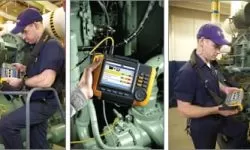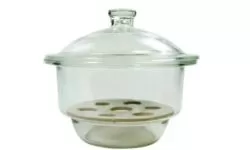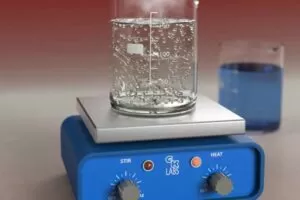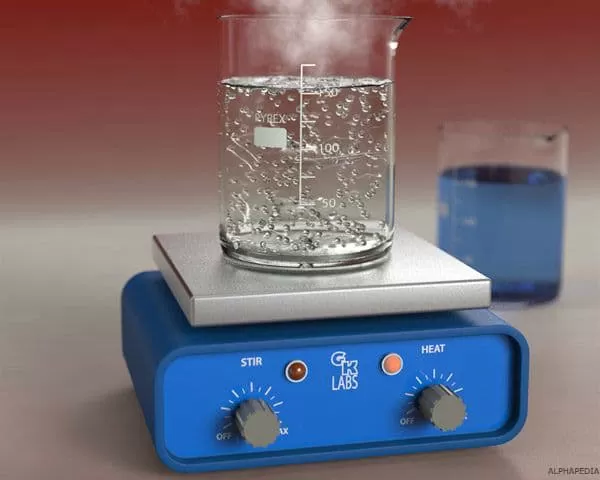Definition of Laboratory Crystallizer
Crystallization is a technique used by chemists to purify solid compounds. It is one of the fundamental procedures that each chemist must master in order to master the laboratory. Crystallization is based on the principles of solubility: compounds (solutes) tend to be more soluble in hot liquids (solvents) than in cold liquids.
If a hot saturated solution is allowed to cool, the solute is no longer soluble in the solvent and forms pure compound crystals. Impurities are excluded from the growing crystals and the pure solid crystals can be separated from the dissolved impurities by filtration.
History and Origin of the Crystallizer
Crystallization is a very old technology, and information related to salt and sugar crystallization dates back to the beginning of civilization. In the last 30 years, the technical means to measure nucleation in operating equipment have been developed.
This has given a new perspective on the design of crystallization equipment with the result that modern crystallization designs are much more flexible in terms of their apacity to control the size and size distribution of crystal products than previous equipment. Crystallization has long been considered an art rather than a science, although recent theoretical discoveries and new analytical techniques have produced a change in this historical position.
Jabir Bin Hayyan conducted his great experiments in science and chemistry in the eighth century during the Abbasid caliphate of Haroon al-Rashid Jabir introduced experimental research into science that quickly changed its character in modern chemistry. His fundamentally important contribution to chemistry included the perfection of scientific techniques such as crystallization, distillation, calcinations, sublimation and evaporation and the development of various instruments for this purpose.
The still is his great invention, which made the process of distillation easy and systematic. Jabir placed great emphasis on experimentation and precision in his work based on its properties, he has described three different types of substances.
Use of the Laboratory Cirstallizer
- Heat a little solvent until it boils.
- Place the solid to be recrystallized in an Erlenmeyer flask.
- Pour a small amount of the hot solvent into the flask containing the solid.
- Shake the flask to dissolve the solid.
- Place the flask in the steam bath to keep the solution warm.
- If the solid is still not dissolved, add a small amount of solvent and shake again.
- When the solid is all in solution, place it on the table. Do not disturb it!
- After a while, crystals should appear in the flask.
- You can now place the flask in an ice bath to complete the crystallization process.
- You are now ready to filter the solution to isolate the crystals.
- Remove the filter paper from the Buchner funnel when you are finished.
- After the crystals have been filtered from the solution, place them in a glass clock.
- Allow the glass to finish drying on the clock.
- To crystallize an impure solid compound, add enough hot solvent to dissolve it completely.
- The flask contains a hot solution, in which the solute molecules, both the desired compound and the impurities, move freely between the hot solvent molecules.
- As the solution cools, the solvent can no longer contain all the solute molecules, and they begin to exit the solution and form solid crystals.
- During this cooling, each solute molecule approaches a growing crystal and rests on the surface of the crystal. If the geometry of the molecule conforms to that of the crystal, it is more likely to remain in the crystal than to return to solution.
- Therefore, each growing crystal consists of only one type of molecule, the solute. Once the solution has reached room temperature, it is carefully placed in an ice bath to complete the crystallization process.
- The cooled solution is then filtered to isolate the pure crystals and the crystals are rinsed with cooled solvent.
Laboratory Crystallizer Price in Euros and Dollars
- Reusable Glass Crystal Dish 60mm, Borosilicate: Price: 7,23
- How to use: wash and dry the crystallized plates and put the mother liquid on the crystallized plates to crystallize
- Made of borosilicate glass, good heat resistance
- Reusable and perfect for storage and crystallization.
Types of Laboratory Crystallizer
There is a wide variety of equipment used to carry out the crystallization process, called crystallizers.
Such equipment can be classified into four general types:
- Bulk solution crystallizers. The crystals are suspended in solution for a significant time while nucleation and growth occurs.
- Vessels of containers. The feed streams entering the vessel generate high levels of oversaturation (by chemical reaction, drowning or salting), forming very rapidly large quantities of small crystals.
- Fusion crystallizers that form multiple crystals. The volume (typically > 90%) of the solution or melt forms crystals in suspension or on a cooled surface. The impurities remain in the small amount of non-crystallized mother liquor.
- Melt crystals that form large individual crystals of high purity. The crystals form very slowly from high purity melts, producing large, pure, flawless crystals. These are typically used for the manufacture of semiconductors.
All of these types of equipment have aspects in common:
- A region where oversaturation is generated to drive crystallization.
- A region where the crystals are in contact with a supersaturated solution for crystal growth
- In some cases, the crystals are present in the entire vessel, suspended by some form of agitation; in other cases, the crystals occupy only a part of the vessel, typically as a fluidized bed.
Glass Crystallizer
The glass crystallizer is generally made of borosilicate which is a glass with high thermal resistance and very good chemical resistance to water, salt solutions, acids, bases and organic solvents.
Industrial Crystallizer
Industrial crystallization processes are aimed at large-scale production of crystalline products by forming a suspension of growing particles in a solution. The quality of the product is defined by the type of crystalline phase produced, the crystal size distribution, the morphology of the crystal and the purity of the product. These aspects of product quality are determined by the crystallization sub-processes, of which the nucleation and growth of the crystals are generally of major importance.
The driving force of these subprocesses is usually established by evaporating the solvent to increase concentration or by cooling the solution to decrease solubility. Recent pharmaceutical research interest in continuous crystallization processes is reinforced by claims of improved product quality, efficient use of materials and energy resources, and reduced waste stream.
Improvements in the understanding of the fundamentals of crystallization have led to the successful resolution of problems encountered in industrial practice. A reduction in process variability and improvements in product quality (crystal shape, product handling, post-processing performance, etc.)
Chemical Crystallizer
Crystallization is one of the most widely used technologies in the chemical industry, and the robustness of the process governs the productivity and economy of the process. In particular, the pharmaceutical and food sectors are using crystallization for optimized separation, purification and solid form selection. For example, crystallization is the most common method of forming pharmaceutical solids for the development of active pharmaceutical ingredients (APIs).
Optimization of particle properties, such as particle size and shape distribution, is paramount, as the physical form determines the quality and efficacy of the drug. Many pharmaceutical drugs have poor physiochemical profiles, such as low solubility in biological fluids. Significant research and development efforts have been made to develop a solid shape landscape covering all possible solid structures, including polymorphs, solvates, co-crystals, salts and the amorphous phase to enhance the development of the active pharmaceutical ingredient (API).
What is Crystallization and What is it Used For? Its Definition
- Crystallization can be seen as a technique to obtain solid products, where the crystallization process must be carefully controlled to meet the increasing customer demands on the properties of the particles.
- Such as particle size distribution, crystal shape, degree of agglomeration, clumping behavior and purity.
- Since the particles must also be easily separated from the mother water, additional demands can be made on filtration capacity and washability.
- Due to the mostly rigid structure of the solid phase, the formation of solid particles is a rather slow process, and large vessels are generally required to achieve an acceptable production rate.
- This rigid structure, on the other hand, prevents the incorporation of foreign substances or solvent molecules, and in only one separation stage a pure solid product is obtained.
- Crystallization is often used as a generic term for crystallization by evaporation or cooling, precipitation and crystallization by fusion.
- However, there are considerable differences between the three types of crystallization in terms of processing method and equipment.
- In precipitation, the abandonment of the solid phase is achieved by mixing two feed streams which are either two reagents or a solvent containing the solute and an anti-solvent.
- The hydrodynamics of the process, therefore, plays a predominant role in precipitation with respect to the properties of the product obtained.
- In fusion crystallization, the crystallization potential to produce a pure product is mainly used, and the solid phase is swirled to obtain the final product.
- Applications are mainly in the ultrapurification of organic compounds or to produce pure water as a concentration technique.
- A material can crystallize naturally or artificially and quickly or on geological time scales.
Examples of Natural Crystallization Include:
Snowflake formation, Honey crystallization in a jar, Stalactite and stalagmite formation, Deposition of gemstone crystals
Examples of artificial crystallization include: Cultivation of sugar crystals in a jar Production of synthetic gems
Who Created Crystallization and in What Year ?
Jabir bin Hayyan was born in 721 A.D. in the Persian city of Tus. He achieved excellence in the fields of Alchemy, Astronomy, Physics, Pharmacy, Philosophy, Astrology and Geography. It has been discovered that it recognizes the early works of Plato, Socrates, Aristotle and Pythagoras, as well as the knowledge of the prominent Muslim jurist Imam Jafar as-Sadiq on alchemy, chemistry, philosophy and astronomy.
Jabir bin Hayyan prepared chemicals, discovered many acids and prepared, as well as, improved many chemical processes. He emphasized the importance of experiencing one’s theory, and that is why we see many inventions and discoveries made by him. In fact, he was the one who introduced experimental techniques into the field of chemistry.
He discovered such significant chemical procedures as crystallization, fusion, distillation, calcination, reduction, liquidation and sublimation. The dyeing of cloth and leather, as well as the preparation of steel are also associated with this great Islamic scientist.
He gave a detailed description of acetic acid, tartaric acid and citric acid. The discovery of hydrochloric acid, sulfuric acid and nitric acid are some of the major contributions made by Jabir bin Hayyan. He combined nitric acid with hydrochloric acid and invented another acid called today “Aqua Regia”. The latter is strong enough to dissolve gold. His division of the substance into three different classes functioned as the basis for the modern classification of metals and non-metals.
What Crystallization Is For
- Crystallization is the separation process by which heat and mass transfer removes solids from a solution in the form of high-purity crystalline structures.
- The two-part process of associated nucleation and crystal growth depends on the relative speed of each step to control crystal size and population.
- Found in a variety of waste management processes and operations, crystallization also reduces liquid waste runoff, as the remaining liquid, also purified, can be recycled through the system, released to the environment or transferred to another operation.
- Crystallization is a process driven by the size and shapes of the molecules involved and their chemical properties.
- Crystals can be formed from a single species of atom, different species of ions or even large molecules such as proteins.
- Some large molecules have more difficulties to undergo the crystallization process, because their internal chemistry is not very symmetric or interacts with itself to avoid crystallization.
- The smallest unit of a crystal is called a unit cell.
- This is the base formation of atoms or molecules on which additional units can be attached. You can think of this as a building block for children, to which other blocks can be attached.
- Crystallization proceeds as if you were joining these blocks in all directions. Some materials form crystals of different shapes, which explains the great variation in shape, size and color of various crystals.
The Crystallization Process
- Two events must occur for crystallization to occur. First, the atoms or molecules are grouped together on the microscopic scale in a process called nucleation.
- If the clusters become stable and large enough, crystal growth can occur.
- Atoms and compounds can usually form more than one crystalline structure (polymorphism). The arrangement of the particles is determined during the nucleation stage of crystallization.
- This can be influenced by multiple factors, such as temperature, particle concentration, pressure and purity of the material.
- In a solution in the crystal growth phase, an equilibrium is established in which the solute particles dissolve back into the solution and precipitate as a solid.
- If the solution is oversaturated, this drives crystallization because the solvent cannot withstand continuous dissolution.
- Sometimes having a supersaturated solution is insufficient to induce crystallization. It may be necessary to provide a seed crystal or a rough surface to start nucleation and growth.
Examples of Crystallization Methods
The crystallization process produces a physical change in the objects. It leads to the formation of crystalline structures. It is not possible to distinguish clearly between crystallization processes. But we can identify two categories of crystallization processes, namely crystallization by cooling and crystallization by evaporation.
Cooling Crystallization: Many substances, when dissolved in solvent, form crystals when cooled under favorable conditions in this process. However, this method is not very common and has many limitations. Generally, the substance is heated and then allowed to cool in this method. Evaporative crystallization is more common than cooling crystallization.
The evaporation of seawater leaves salt behind. The pure crystals of substance are deposited after the evaporation of the solutions. But this method requires a high concentration of the substance in the solution. Therefore, its mass ratio solute / solvent must be high.
Simple experiments to demonstrate crystallization:
Experiment 1
- First, drink some water in a beaker. Add a few drops of dilute sulfuric acid (H2SO4).
- Heat the mixture in a burner. Add copper sulphate powder when it starts to boil.
- Keep stirring the solution. Continue to add copper sulfate powder to the solution until it becomes soluble.
- Now filter the solution and allow it to cool.
- You will see copper sulfate crystals suspended in the solution.
Experiment 2
- Put 160 grams of sodium acetate in a flask and add 30 ml of water.
- Heat the flask on a burner or hot plate until it begins to boil.
- Shake the solution unless the sodium acetate crystals dissolve.
- Now remove the flask from the heat and let it cool down for a while.
- Finally, place one or two sodium acetate crystals on a surface and pour the solution over it.
- Try to keep the solution flow constant.
- The solution will solidify and form a vertical structure.
Cooling Crystallization
Crystallization by cooling is attractive when the solubility of the product increases significantly with increasing temperature. In a cooling crystallization process, the feed is cooled in a heat exchanger, which can be located inside the crystallizer or in an external circuit.
The wall of the crystallizer can be used as an internal heat exchanger, but the heat exchanger can also be integrated into the crystallizer in the form of cooled tubes or plates. Crystallization can take place when the liquid is cooled down to a temperature below the equilibrium solubility. The lowest temperature in the system is on the surface of the heat exchanger.
Therefore, cooling must be done carefully to avoid nucleation on the cold surface of the heat exchanger, which will cause scaling. Generally, measures to prevent this unwanted phenomenon are to reduce the temperature difference between the refrigerant and the crystallization solution.
Increase the velocity of the liquid along the surface of the heat exchanger to level the temperature difference along the heat exchanger or use a scraper to keep the surface of the heat exchanger free of solids. Alternative cooling methods that do not require a heat exchanger are flash cooling involving (partial) evaporation of the solvent or direct cooling by inserting a cold gas or refrigerant.
Fractionated Crystallization
Fractionated crystallization is a term used to describe a process in which repeated crystallization steps are used to increase product purity and/or increase process yield. Applications can be found in metal, metal refining, oil and gas, e.g. dewaxing of oil, food, e.g. fractionation of palm oil and freezing concentration and in chemical industries, e.g. degreasing with kerosene wax or ultra-purification of chemicals.
In a fractionated crystallization process, the crystals formed in the first stage are separated from the mother water with devices such as filters, centrifuges or washing columns and are rewound for use as feed in a second crystallization stage.
Other Laboratory Materials and Instruments in ALPHAPEDIA

SAFETY GOGGLES USES

BEAKER FEATURES

WASH BOTTLE: Definition, Use and Capacity

💚 VIBRATION SPECTRUM ANALYSIS

DESICCATOR: Definition, Use, Function and Price

WHAT IS A BEAKER ? Its Definition
Other Topics of Interest in ALPHAPEDIA

FREE ASSISTING IN HOME CARE COURSE

FREE GENERAL CULTURE COURSE

FREE BACHELOR DEGREE IN ANIMATION

FREE BACHELOR OF SCIENCE IN BUSINESS

FREE BACHELOR DEGREE IN GASTRONOMY

ENVIRONMENT DEFINITION
Image and Photo of the Crystallizer



